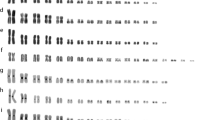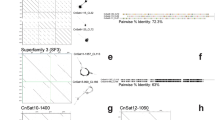Abstract
Crocodilians have several unique karyotypic features, such as small diploid chromosome numbers (30–42) and the absence of dot-shaped microchromosomes. Of the extant crocodilian species, the Siamese crocodile (Crocodylus siamensis) has no more than 2n = 30, comprising mostly bi-armed chromosomes with large centromeric heterochromatin blocks. To investigate the molecular structures of C-heterochromatin and genomic compartmentalization in the karyotype, characterized by the disappearance of tiny microchromosomes and reduced chromosome number, we performed molecular cloning of centromeric repetitive sequences and chromosome mapping of the 18S-28S rDNA and telomeric (TTAGGG) n sequences. The centromeric heterochromatin was composed mainly of two repetitive sequence families whose characteristics were quite different. Two types of GC-rich CSI-HindIII family sequences, the 305 bp CSI-HindIII-S (G+C content, 61.3%) and 424 bp CSI-HindIII-M (63.1%), were localized to the intensely PI-stained centric regions of all chromosomes, except for chromosome 2 with PI-negative heterochromatin. The 94 bp CSI-DraI (G+C content, 48.9%) was tandem-arrayed satellite DNA and localized to chromosome 2 and four pairs of small-sized chromosomes. The chromosomal size-dependent genomic compartmentalization that is supposedly unique to the Archosauromorpha was probably lost in the crocodilian lineage with the disappearance of microchromosomes followed by the homogenization of centromeric repetitive sequences between chromosomes, except for chromosome 2.









Similar content being viewed by others
Abbreviations
- AMI:
-
Alligator mississippiesis
- ASI:
-
Alligator sinensis
- BCO:
-
Boa constrictor
- BrdU:
-
5-bromodeoxyuridine
- BSG:
-
barium hydroxide/saline/Giemsa
- CCD:
-
charge-coupled device
- CCR:
-
Caiman crocodilus
- CLA:
-
Caiman latirostris
- CNI:
-
Crocodylus niloticus
- CSI:
-
Crocodylus siamensis
- Cy3:
-
orange-fluorescing cyanine
- DDBJ:
-
DNA Data Bank of Japan
- Dig:
-
digoxigenin
- EQU:
-
Elaphe quadrivirgata
- FISH:
-
fluorescence in-situ hybridization
- FITC:
-
fluorescein isothiocyanate
- GGA:
-
Gavialis gangeticus
- GHO:
-
Gekko hokouensis
- Mya:
-
million years ago
- NF:
-
fundamental number
- PCR:
-
polymerase chain reaction
- PI:
-
propidium iodide
- PFL:
-
Protobothrops flavoviridis
- PMO:
-
Python molurus bivittatus
- PSI:
-
Pelodiscus sinensis
- rDNA (RNA):
-
ribosomal DNA (RNA)
- SDS:
-
sodium dodecyl sulfate
- SSC:
-
saline sodium citrate
- TSC:
-
Tomistoma schlegelii
- UV:
-
ultraviolet
References
Andreozzi L, Federico C, Motta S et al. (2001) Compositional mapping of chicken chromosomes and identification of the gene-richest regions. Chromosome Res 9: 521–532.
Baldini A, Miller DA, Miller OJ, Ryder OA, Mitchell AR (1991) A chimpanzee-derived chromosome-specific alpha satellite DNA sequence conserved between chimpanzee and human. Chromosoma 100: 156–161.
Belle EMS, Smith N, Eyre-Walker A (2002) Analysis of the phylogenetic distribution of isochores in vertebrates and a test of the thermal stability hypothesis. J Mol Evol 55: 356–363.
Belterman RHR, de Boer LEM (1984) A karyological study of 55 species of birds, including karyotypes of 39 species new to cytology. Genetica 65: 39–82.
Burt DW (2002) Origin and evolution of avian microchromosomes. Cytogenet Genome Res 96: 97–112.
Chavananikul V, Suwattana D, Wattanodorn S, Koykul W (1998) Karyotypes and NORs banding patterns in Crocodylus siamensis and Crocodylus porosus. Proc 6th World Congress on Genetics Applied to Livestock Production 25: 319–322.
Cohen MM, Gans C (1970) The chromosomes of the order Crocodilia. Cytogenetics 9: 81–105.
Cracraft J (2001) Avian evolution, Gondwana biogeography and the Cretaceous-Tertiary mass extinction event. Proc R Soc Lond B 268: 459–469.
Ferguson MWJ, Joanen T (1982) Temperature of egg incubation determines sex in Alligator mississippiensis. Nature 296: 850–853.
Gatesy J, Amato G, Norell M, DeSalle R, Hayashi C (2003) Combined support for wholesale taxic atavism in gavialine crocodylians. Syst Biol 52: 403–422.
Hamada K, Horiike T, Kanaya S et al. (2002) Changes in body temperature pattern in vertebrates do not influence the codon usages of α-globin genes. Genes Genet Syst 77: 197–207.
Hamada K, Horiike T, Ota H, Mizuno K, Shinozawa T (2003) Presence of isochore structures in reptile genomes suggested by the relationship between GC contents of intron regions and those of coding regions. Genes Genet Syst 78: 195–198.
Harshman J, Huddleston CJ, Bollback JP, Parsons TJ, Braun MJ (2003) True and false gharials: a nuclear gene phylogeny of Crocodylia. Syst Biol 52: 386–402.
Head G, May RM, Pendleton L (1987) Environmental determination of sex in the reptiles. Nature 329: 198–199.
Hilton-Taylor C (2000) 2000 IUCN Red List of Threatened Species. Gland and Cambridge: IUCN.
Hughes S, Zelus D, Mouchiroud D (1999) Warm-blooded isochore structure in Nile crocodile and turtle. Mol Biol Evol 16: 1521–1527.
ICGSC (International Chicken Genome Sequencing Consortium) (2004) Sequence and comparative analysis of the chicken genome provide unique perspectives on vertebrate evolution. Nature 432: 695–716.
Iwabe N, Hara Y, Kumazawa Y et al. (2005) Sister group relationship of turtles to the bird-crocodilian clade revealed by nuclear DNA-coded proteins. Mol Biol Evol 22: 810–813.
Janke A, Arnason U (1997) The complete mitochondrial genome of Alligator mississippiensis and the separation between recent Archosauria (birds and crocodiles). Mol Biol Evol 14: 1266–1272.
Janke A, Erpenbeck D, Nilsson M, Arnason U (2001) The mitochondrial genomes of the iguana (Iguana iguana) and the caiman (Caiman crocodylus) implications for amniote phylogeny. Proc R Soc Lond B 268: 623–631.
King M (1983) The Gehyra australis species complex (Sauria: Gekkonidae). Amphibia-Reptilia 4: 147–169.
Kumar S, Hedges SB (1998) A molecular timescale for vertebrate evolution. Nature 392: 917–920.
Kumazawa Y (2007) Mitochondrial genomes from major lizard families suggest their phylogenetic relationships and ancient radiations. Gene 388: 19–26.
Kumazawa Y, Nishida M (1999) Complete mitochondrial DNA sequences of the green turtle and blue-tailed mole skink: statistical evidence for Archosaurian affinity of turtles. Mol Biol Evol 16: 784–792.
Kuraku S, Ishijima J, Nishida-Umehara C, Agata K, Kuratani S, Matsuda Y (2006) cDNA-based gene mapping and GC3 profiling in the soft-shelled turtle suggest a chromosomal size-dependent GC bias shared by sauropsids. Chromosome Res 14: 187–202.
Lang JW, Andrews HV (1994) Temperature-dependent sex determination in crocodilians. J Exp Zool 270: 28–44.
Matsuda Y, Chapman VM (1995) Application of fluorescence in-situ hybridization in genome analysis of the mouse. Electrophoresis 16: 261–272.
Matsuda Y, Nishida-Umehara C, Tarui H et al. (2005) Highly conserved linkage homology between birds and turtles: Bird and turtle chromosomes are precise counterparts of each other. Chromosome Res 13: 601–615.
Matzke MA, Varga F, Berger H et al. (1990) A 41–42 bp tandemly repeated sequence isolated from nuclear envelopes of chicken erythrocytes is located predominantly on microchromosomes. Chromosoma 99: 131–137.
Matzke AJM, Varga F, Gruendler P et al. (1992) Characterization of a new repetitive sequence that is enriched on microchromosomes of turkey. Chromosoma 102: 9–14.
McQueen HA, Fantes J, Cross SH, Clark VH, Archibald AL, Bird AP (1996) CpG islands of chicken are concentrated on microchromosomes. Nature Genet 12: 321–324.
McQueen HA, Siriaco G, Bird AP (1998) Chicken microchromosomes are hyperacetylated, early replicating, and gene rich. Genome Res 8: 621–630.
Nishida-Umehara C, Tsuda Y, Ishijima J et al. (2007) The molecular basis of chromosome orthologies and sex chromosomal differentiation in palaeognathous birds. Chromosome Res 15: 721–734.
Olmo E, Signorino G (2005) Chromorep: a reptile chromosomes database. Internet references. Retrieved from: http://ginux.univpm.it/scienze/chromorep/.
Ota H, Chen SL, Shang G (1998) Japalura luei, a new agamid lizard from Taiwan. Copeia 1998: 649–656.
Primmer CR, Raudsepp T, Chowdhary BP, Møller AP, Ellegren H (1997) Low frequency of microsatellites in the avian genome. Genome Res 7: 471–482.
Polet G, Murphy DJ, Phan Viet Lam, Tran Van Mui (2002) Crocodile conservation at work in Vietnam, re-establishing Crocodylus siamensis in Cat Tien National Park. In Crocodiles: Proceedings of the 16th Working Meeting of the Crocodile Specialist Group of the Species Survival Commission of IUCN-The World Conservation Union. Gland and Cambridge: IUCN, pp. 86–95.
Rest JS, Ast JC, Austin CC et al. (2003) Molecular systematics of primary reptilian lineages and the tuatara mitochondrial genome. Mol Phylogent Evol 29: 289–297.
Ross CA, Magnusson WE (1989) Living crocodilians. In Ross CA, ed. Crocodiles and Alligators. New York: Facts On File, pp. 58–73.
Shibusawa M, Nishibori M, Nishida-Umehara C et al. (2004) Karyotypic evolution in the Galliformes: an examination of the process of karyotypic evolution by comparison of the molecular cytogenetic findings with the molecular phylogeny. Cytogenet Genome Res 106: 111–119.
Sibley CG, Ahlquist JE (1990) Phylogeny and Classification of Birds: A Study in Molecular Evolution. New Haven: Yale University Press.
Smith J, Burt DW (1998) Parameters of the chicken genome (Gallus gallus). Anim Genet 29: 290–294.
Smith J, Bruley CK, Paton IR et al. (2000) Differences in gene density on chicken macrochromosomes and microchromosomes. Anim Genet 31: 96–103.
Sumner AT (1972) A simple technique for demonstrating centromeric heterochromatin. Exp Cell Res 75: 304–306.
Suzuki T, Kurosaki, T, Agata K et al. (1999) Cytogenetic assignment of 29 functional genes to chicken microchromosomes by FISH. Cytogenet Cell Genet 87: 233–237.
Takagi N, Sasaki M (1974) A phylogenetic study of bird karyotypes. Chromosoma 46: 91–120.
Tanaka K, Suzuki T, Nojiri T, Yamagata T, Namikawa T, Matsuda Y (2000) Characterization and chromosomal distribution of a novel satellite DNA sequence of Japanese quail (Coturnix coturnix japonica). J Hered 91: 412–415.
Tsuda Y, Nishida-Umehara C, Ishijima J, Yamada Y, Matsuda Y (2007) Comparison of the Z and W sex chromosomal architectures in elegant crested tinamou (Eudromia elegans) and ostrich (Struthio camelus) and the process of sex chromosome differentiation in palaeognathous birds. Chromosoma 116: 159–173.
Valenzuela N, Lance V, eds. (2004) Temperature-Dependent Sex Determination in Vertebrates. Smithonian Books, Washington.
van Tuinen M, Hedges SB (2001) Calibration of avian molecular clocks. Mol Biol Evol 18: 206–213.
Waye JS, Willard HF (1989) Concerted evolution of alpha satellite DNA: Evidence for species specificity and a general lack of sequence conservation among alphoid sequences of higher primates. Chromosoma 98: 273–279.
Yamada K, Nishida-Umehara C, Matsuda Y (2002a) Characterization and chromosomal distribution of novel satellite DNA sequences of the lesser rhea (Pterocnemia pennata) and the greater rhea (Rhea americana). Chromosome Res 10: 513–523.
Yamada K, Shibusawa M, Tsudzuki M, Matsuda Y (2002b) Molecular cloning and characterization of novel centromeric repetitive DNA sequences in the blue-breasted quail (Coturnix chinensis, Galliformes). Cytogenet Genome Res 98: 255–261.
Yamada K, Nishida-Umehara C, Matsuda Y (2005) Molecular and cytogenetic characterization of site-specific repetitive DNA sequences in the Chinese soft-shelled turtle (Pelodiscus sinensis, Trionychidae). Chromosome Res 13: 33–46.
Acknowledgements
This work was supported by Grants-in-Aid for Scientific Research (nos. 15370001 and 16086201) from the Ministry of Education, Culture, Sports, Science and Technology, Japan.
Author information
Authors and Affiliations
Corresponding author
Rights and permissions
About this article
Cite this article
Kawagoshi, T., Nishida, C., Ota, H. et al. Molecular structures of centromeric heterochromatin and karyotypic evolution in the Siamese crocodile (Crocodylus siamensis) (Crocodylidae, Crocodylia). Chromosome Res 16, 1119–1132 (2008). https://doi.org/10.1007/s10577-008-1263-1
Received:
Revised:
Accepted:
Published:
Issue Date:
DOI: https://doi.org/10.1007/s10577-008-1263-1




